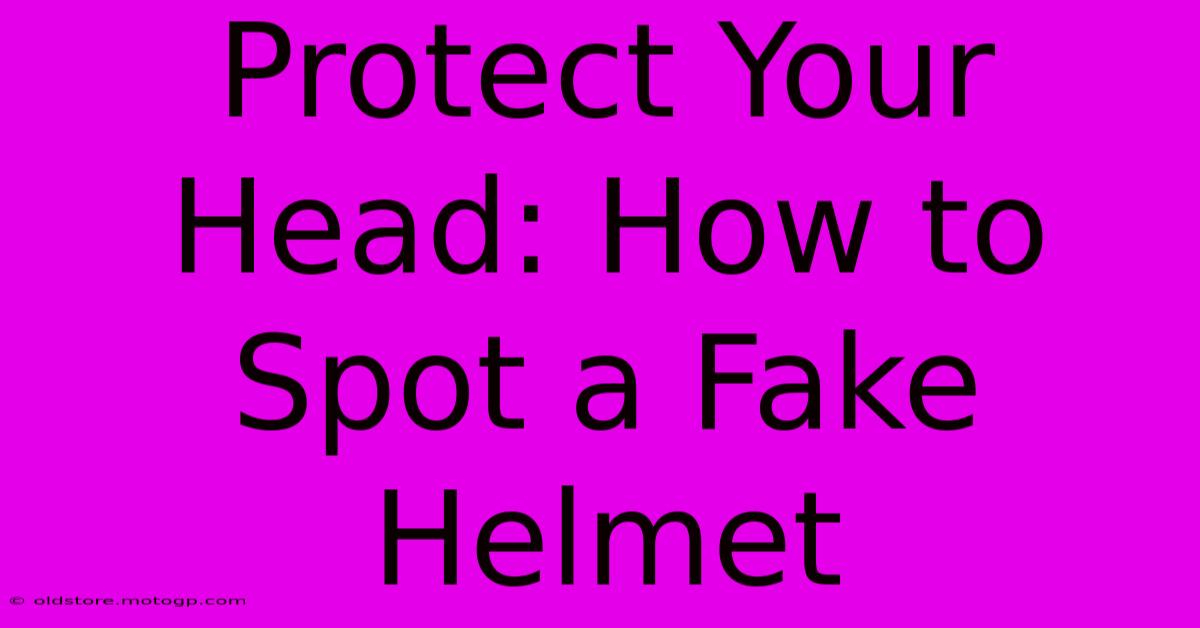Protect Your Head: How To Spot A Fake Helmet

Table of Contents
Protect Your Head: How to Spot a Fake Helmet
A helmet is your first line of defense against serious head injuries. Whether you're a cyclist, motorcyclist, skateboarder, or simply someone who values head safety, investing in a helmet is crucial. But the market is flooded with counterfeit helmets, posing a significant risk. This guide will empower you to identify fake helmets and ensure you're wearing genuine protection.
The Dangers of Fake Helmets
The most significant danger of wearing a fake helmet is its lack of safety certification and testing. Reputable helmets undergo rigorous testing to meet specific safety standards (like DOT, ECE, Snell, etc., depending on your region). Fake helmets often skip these crucial steps, meaning they may not offer the protection you expect in a crash. This can lead to:
- Increased risk of head trauma: A poorly constructed helmet might crack, shatter, or deform improperly during an impact, leaving you vulnerable to serious injury.
- False sense of security: Believing you're protected when you're not can be incredibly dangerous. You might take more risks thinking your helmet will safeguard you.
- Legal implications: In some regions, wearing uncertified safety equipment can have legal ramifications.
How to Identify a Fake Helmet
Identifying a fake helmet requires careful attention to detail. Here's a checklist to help you:
1. Check for Certification Marks:
- Look for the certification label: Genuine helmets prominently display certifications like DOT (US Department of Transportation), ECE (Economic Commission for Europe), Snell, or others relevant to your country. These marks indicate the helmet has met specific safety standards.
- Verify the markings: Don't just look for the logo; ensure the label itself looks authentic. Counterfeit labels are often poorly printed, blurry, or oddly placed.
- Check the manufacturer's website: Confirm the certification markings on the helmet match those listed by the manufacturer for that specific model.
2. Examine the Quality of the Helmet:
- Material and Finish: Fake helmets often have a poor-quality finish, with rough edges, uneven paint, or noticeable imperfections. Genuine helmets usually have a smooth, consistent finish.
- Straps and Buckles: Examine the straps and buckles. Are they securely stitched? Do they feel sturdy and well-made? Flimsy straps and cheap buckles are red flags.
- Padding and Liner: Check the padding inside the helmet. Is it comfortable and properly fitted? Cheap materials or loose padding indicate a potential fake.
- Weight: A surprisingly light or heavy helmet compared to similar models might be a sign of substandard materials.
3. Investigate the Purchase Source:
- Buy from reputable dealers: Purchase your helmet from authorized dealers or reputable retailers. Avoid suspiciously cheap prices from unknown online sellers or unauthorized vendors.
- Be wary of incredibly low prices: If a deal seems too good to be true, it probably is. Genuine helmets are generally not sold at heavily discounted prices.
- Check reviews and feedback: Before buying, read reviews and check customer feedback about the seller and the specific helmet model.
4. Inspect the Packaging:
- Authentic Packaging: Genuine helmets usually come in well-designed packaging with clear labeling and information. Poor-quality or generic packaging should raise concerns.
Where to Buy Authentic Helmets:
Always prioritize purchasing your helmet from authorized retailers, reputable sporting goods stores, or directly from the manufacturer's website. These sources provide more assurance that you're getting a genuine, safety-tested product.
Protecting your head is non-negotiable. Don't compromise your safety by purchasing a fake helmet. By carefully following these tips, you can increase your chances of finding a genuine helmet and ensuring your head is well-protected. Remember, your safety is worth the investment.

Thank you for visiting our website wich cover about Protect Your Head: How To Spot A Fake Helmet. We hope the information provided has been useful to you. Feel free to contact us if you have any questions or need further assistance. See you next time and dont miss to bookmark.
Featured Posts
-
Used Racing Motorcycles Great Value And Performance
Feb 21, 2025
-
Speed Moto Gp The Ultimate Test Of Skill
Feb 21, 2025
-
Cota Merchandise From The Grand Prix To Your Closet
Feb 21, 2025
-
Your Cota Parking Solution Lot T
Feb 21, 2025
-
Us Gp Sprint The Future Of Motorsport
Feb 21, 2025
